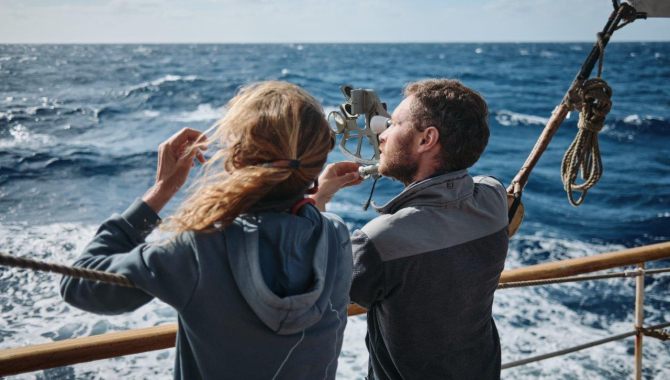We keep the good Southeasterlies entering the latitudes of the 20ºS

Sometimes there’s no wind, then you sit and wait, or if necessary, you can always start the engines to seek where it is blowing, or on other occasions when it blows against you.
When it is fair, you can sail it under an assorted array of canvas, using combinations of the 22 sails that are rigged at the moment and the different angles of their yards, pulling on their braces now more here, then there.
But now and for a few days in a row, of wind we had and have enough. Call it the southern edge where the Southeasterly Trade Winds start, or the effects of sailing on the front border of a pretty stable High Pressure. The wind kept blowing from a steady Southeasterly direction.
Trade Winds, often considered an integral part of the navigation at those latitudes, just leaving the 30ºS behind and entering the 20ºS, are one of the pretty stable general patterns of circulation of the world’s winds. They blow over most of the tropics, from the Subtropical Highs to the Equatorial Lows. South of them, we left behind the predominant westerlies that sweep over the Southern Ocean from the Subtropical High to the Polar Front.
They have an effect too on the water circulation, as they drive an important oceanic flow, the Benguela Current. The northward-flowing ocean current that forms the eastern portion of the South Atlantic Ocean gyre. Closer to the African coast, the south-easterly winds drive coastal upwelling, forming the Benguela Upwelling System.
Both with us, pushing and pulling the ship northwards on our way from higher latitudes to Namibia, in the past, they represented an obstacle to overcome for the first European explorers that ventured these waters after departing from Portugal and reaching this further south. They slowed down and made for a difficult navigation of the 1487 expedition of Bartolomeu Diaz; ten years later Vasco da Gama took notice of it and routed his journey accordingly, on what became the traditional route to sail from Europe around Africa and to the East Indies, taking better advantage of Trade Winds and currents.
Winds that were known but not put on the world’s maps until the buccaneer captain William Dampier started to collect for the first time data on currents, winds, and tides across all the world’s oceans during his three world circumnavigations between 1679-91. His scientific interest led him too to make notes and study local flora and fauna during his voyages. It was all published in 1697 in a volume called “A New Voyage Around the World”. His nautical, oceanographical, and meteorological observations, were most appreciated by Captain Cook in his trips, and by both Alexander van Humboldt and Charles Darwin.
And so the southeasterly winds keep blowing and the northbound current flowing, day after day, making for yet another good sailing journey. Just like yesterday, the wind seems to follow a pattern of picking up at the end of the afternoon. Same time too for dealing with a few passing squalls, and then ease down a bit in the early hours of the new day. Then there’s the only bit of sail handling, dousing Top Gallants and Outer Jib, or setting them up again when the conditions abate. During the rest of the day, and with less than 500nm to go until reaching Walvis Bay, it is time now to start preparing the ship for the upcoming period when she will take a rest from sailing and go through a few weeks of shipyard. And when she is readied again, she will sail new adventures across the Atlantic. Tropics, Doldrums, Equator, South America, and Europe, all lay ahead for her following trips.



